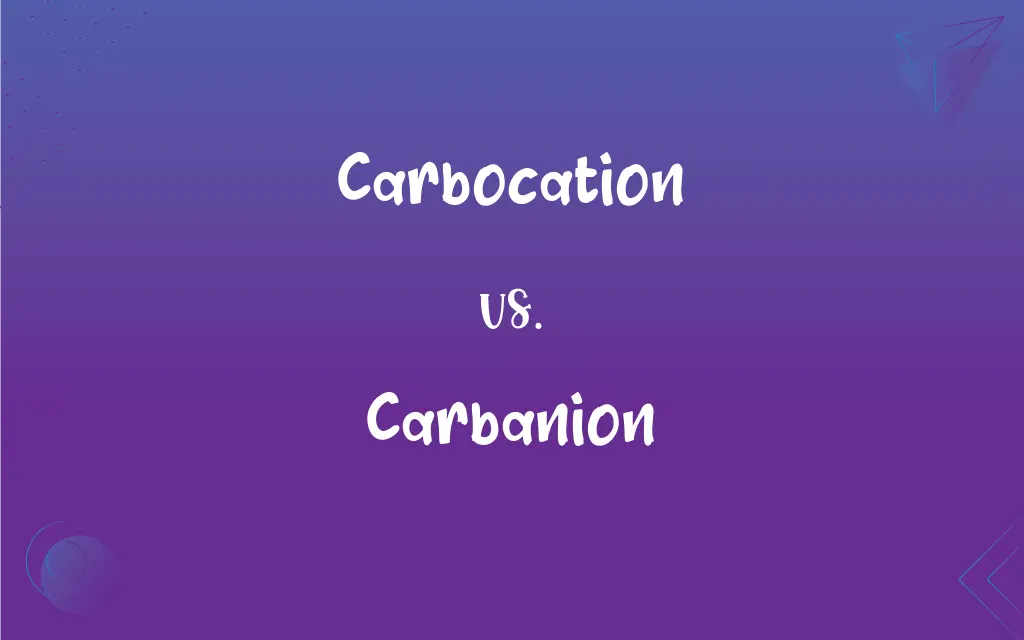Carbocation vs. Carbanion: What's the Difference?
Edited by Aimie Carlson || By Harlon Moss || Updated on October 15, 2023
Carbocation is a positively charged carbon atom, whereas carbanion is a negatively charged carbon atom.

Key Differences
In the world of organic chemistry, carbocations are species characterized by a carbon atom bearing a positive charge. Conversely, carbanions feature a carbon atom that carries a negative charge.
The stability of carbocations is generally influenced by the presence of electron-donating groups or atoms, which can help distribute the positive charge. On the other hand, carbanions gain stability from electron-withdrawing groups or atoms that can help spread out the negative charge.
When considering reactions, carbocations often serve as intermediates in electrophilic addition and substitution reactions, showcasing their nature to seek electrons. In contrast, carbanions play roles in nucleophilic addition or substitution reactions, owing to their propensity to donate electrons.
Carbocations typically form in acidic environments or under conditions that can remove an electron pair. In contrast, carbanions generally form in basic conditions or environments that provide an extra electron pair.
From a structural viewpoint, carbocations are often planar with sp2 hybridization at the positively charged carbon. In comparison, carbanions usually have a pyramidal shape and feature sp3 hybridization at the negatively charged carbon.
ADVERTISEMENT
Comparison Chart
Charge
Positive
Negative
Stability Influencers
Electron-donating groups
Electron-withdrawing groups
Role in Reactions
Electrophilic addition/substitution
Nucleophilic addition/substitution
Formation Environment
Acidic or electron-pair removing
Basic or electron-pair donating
Structural Hybridization
Sp2 (planar)
Sp3 (pyramidal)
ADVERTISEMENT
Carbocation and Carbanion Definitions
Carbocation
A carbon atom lacking a full octet, making it electron-deficient.
The carbocation formed was stabilized by adjacent electron-donating groups.
Carbanion
A carbon atom with an extra electron pair, making it electron-rich.
The carbanion was stabilized by adjacent electron-withdrawing groups.
Carbocation
An electron-deficient carbon that often forms in acidic environments.
Under the acidic conditions, a carbocation was generated as an intermediate.
Carbanion
A molecular species with a negatively charged carbon atom.
The carbanion was a key intermediate in the synthesis.
Carbocation
A molecular species with a positively charged carbon atom.
The formation of the carbocation intermediate is a crucial step in many reactions.
Carbanion
A nucleophilic species ready to donate electrons.
The carbanion attacked the electrophilic carbon center.
Carbocation
An electrophilic species that seeks to gain electrons.
The carbocation readily reacted with the available nucleophile.
Carbanion
A molecule or ion with a trivalent negatively charged carbon atom.
The carbanion intermediate facilitated the reaction's progression.
Carbocation
A molecule or ion with a trivalent positively charged carbon atom.
The carbocation was identified as the reaction intermediate.
Carbanion
An electron-rich carbon that often forms in basic environments.
In the basic medium, a carbanion was generated, driving the reaction forward.
Carbocation
An ion that has a positively charged carbon atom.
Carbanion
An anion in which carbon carries a negative charge and an unshared pair of electrons.
Carbocation
(chemistry) any cation containing an excess positive charge on one or more carbon atoms
Carbanion
(organic chemistry) any organic anion of general formula R3C- Category:en:Carbon
FAQs
What is a carbanion?
A carbanion is a carbon atom with a negative charge.
How do carbocations form?
Carbocations form in acidic environments or when an electron pair is removed.
How do carbanions form?
Carbanions form in basic conditions or when an extra electron pair is provided.
Are carbocations electrophilic or nucleophilic?
Carbocations are electrophilic.
Which is more reactive, a carbocation or carbanion?
Reactivity depends on the context, but both are highly reactive due to their charges.
How can one detect the presence of a carbanion?
NMR and other spectroscopic methods can indicate carbanion presence.
How can one detect the presence of a carbocation?
Some spectroscopic methods, like NMR, can suggest carbocation presence.
Do carbanions always have three bonds?
Typically, yes, along with an additional lone pair, making them negatively charged.
Why are carbocations and carbanions important in organic chemistry?
They play critical roles as intermediates in many chemical reactions, influencing reaction pathways and outcomes.
What stabilizes a carbocation?
Electron-donating groups help stabilize carbocations.
What stabilizes a carbanion?
Electron-withdrawing groups help stabilize carbanions.
What is the geometry of a carbocation?
Carbocations are typically planar with sp2 hybridization.
What is the geometry of a carbanion?
Carbanions typically have a pyramidal shape with sp3 hybridization.
Can carbocations participate in resonance?
Yes, resonance can stabilize carbocations.
Are carbanions common reaction intermediates?
Yes, they are intermediates in certain types of organic reactions.
What is a carbocation?
A carbocation is a carbon atom with a positive charge.
Are carbocations common reaction intermediates?
Yes, they are intermediates in many organic reactions.
Do carbocations always have three bonds?
Typically, yes, as they are trivalent and positively charged.
Are carbanions electrophilic or nucleophilic?
Carbanions are nucleophilic.
Can carbanions participate in resonance?
Yes, resonance can stabilize carbanions.
About Author
Written by
Harlon MossHarlon is a seasoned quality moderator and accomplished content writer for Difference Wiki. An alumnus of the prestigious University of California, he earned his degree in Computer Science. Leveraging his academic background, Harlon brings a meticulous and informed perspective to his work, ensuring content accuracy and excellence.
Edited by
Aimie CarlsonAimie Carlson, holding a master's degree in English literature, is a fervent English language enthusiast. She lends her writing talents to Difference Wiki, a prominent website that specializes in comparisons, offering readers insightful analyses that both captivate and inform.
































































